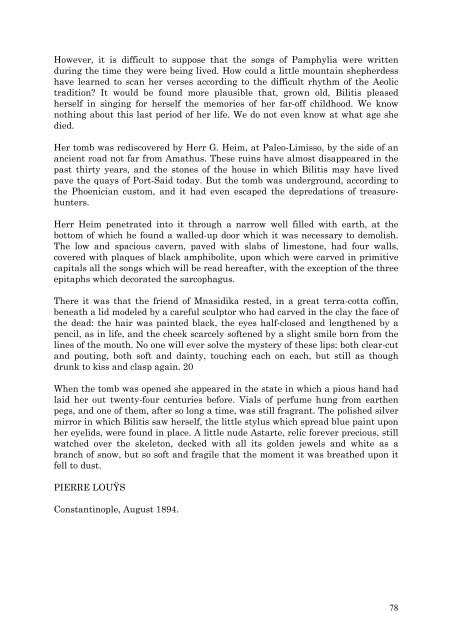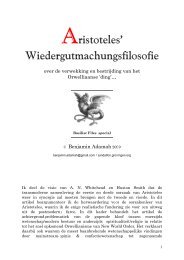Create successful ePaper yourself
Turn your PDF publications into a flip-book with our unique Google optimized e-Paper software.
However, it is difficult to suppose that the songs <strong>of</strong> Pamphylia were written<br />
during the time they were being lived. How could a little mountain shepherdess<br />
have learned to scan her verses according to the difficult rhythm <strong>of</strong> the Aeolic<br />
tradition? It would be found more plausible that, grown old, <strong>Bilitis</strong> pleased<br />
herself in singing for herself the memories <strong>of</strong> her far-<strong>of</strong>f childhood. We know<br />
nothing about this last period <strong>of</strong> her life. We do not even know at what age she<br />
died.<br />
Her tomb was rediscovered by Herr G. Heim, at Paleo-Limisso, by the side <strong>of</strong> an<br />
ancient road not far from Amathus. These ruins have almost disappeared in the<br />
past thirty years, and the stones <strong>of</strong> the house in which <strong>Bilitis</strong> may have lived<br />
pave the quays <strong>of</strong> Port-Said today. But the tomb was underground, according to<br />
the Phoenician custom, and it had even escaped the depredations <strong>of</strong> treasurehunters.<br />
Herr Heim penetrated into it through a narrow well filled with earth, at the<br />
bottom <strong>of</strong> which he found a walled-up door which it was necessary to demolish.<br />
The low and spacious cavern, paved with slabs <strong>of</strong> limestone, had four walls,<br />
covered with plaques <strong>of</strong> black amphibolite, upon which were carved in primitive<br />
capitals all the songs which will be read hereafter, with the exception <strong>of</strong> the three<br />
epitaphs which decorated the sarcophagus.<br />
There it was that the friend <strong>of</strong> Mnasidika rested, in a great terra-cotta c<strong>of</strong>fin,<br />
beneath a lid modeled by a careful sculptor who had carved in the clay the face <strong>of</strong><br />
the dead: the hair was painted black, the eyes half-closed and lengthened by a<br />
pencil, as in life, and the cheek scarcely s<strong>of</strong>tened by a slight smile born from the<br />
lines <strong>of</strong> the mouth. No one will ever solve the mystery <strong>of</strong> these lips: both clear-cut<br />
and pouting, both s<strong>of</strong>t and dainty, touching each on each, but still as though<br />
drunk to kiss and clasp again. 20<br />
When the tomb was opened she appeared in the state in which a pious hand had<br />
laid her out twenty-four centuries before. Vials <strong>of</strong> perfume hung from earthen<br />
pegs, and one <strong>of</strong> them, after so long a time, was still fragrant. The polished silver<br />
mirror in which <strong>Bilitis</strong> saw herself, the little stylus which spread blue paint upon<br />
her eyelids, were found in place. A little nude Astarte, relic forever precious, still<br />
watched over the skeleton, decked with all its golden jewels and white as a<br />
branch <strong>of</strong> snow, but so s<strong>of</strong>t and fragile that the moment it was breathed upon it<br />
fell to dust.<br />
PIERRE LOUŸS<br />
Constantinople, August 1894.<br />
78








